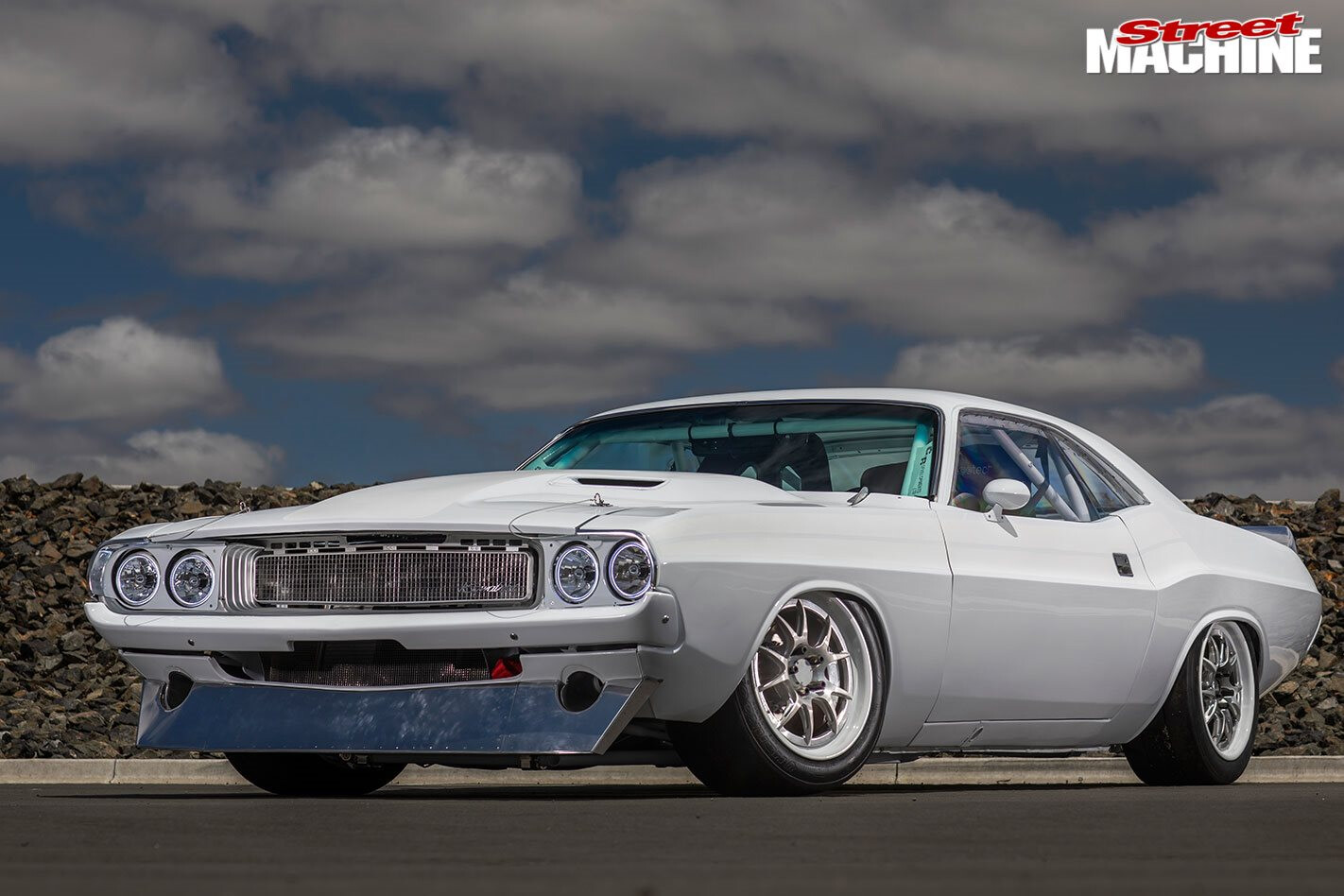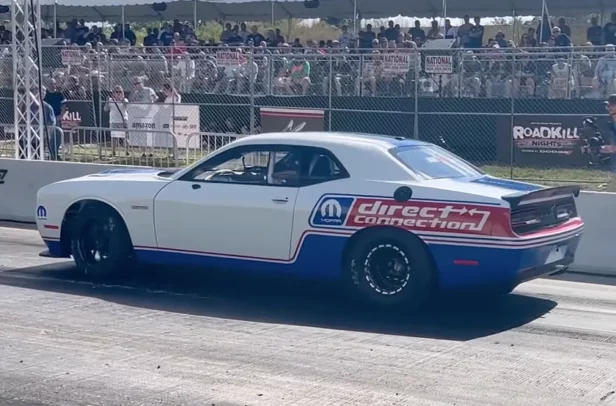DUBBED Kowalski, after the main character in Vanishing Point, this 800hp 1970 Dodge Challenger is owned by four Kiwi brothers: Mike, Tony, Tim and Simon Ross. With a background in muscle and race cars, they decided several years ago to build a muscle car that combined all the best engineering from NASCAR and Trans-Am, with the finish of a high-end show car. And it will actually run wheel-to-wheel with other muscle cars on the race track!
This article was first published in the May 2019 issue of Street Machine
While it’s named after the anti-hero pilot of the Challenger R/T in the film Vanishing Point, this E-body’s specs and aesthetic draw heavily from the Challenger T/A that Sam Posey raced in Trans-Am in 1970 for the factory Dodge team
Nick Mitchell and his team at Mitchell Race Xtreme are the blokes who actually swung the spanners, investing more than 2000 hours over two years to turn a bare shell into the corner-carving monster you see here.
“The car has turned into such a showpiece that we had to give each and every part the special treatment, even painting the two-piece driveshaft in the same Artic White that adorns anything on the car that isn’t polished,” says Nick
“We were at the launch of Mike Ross’s son Nick’s Nissan Altima touring car when Mike started talking to me about building a new muscle car,” Nick Mitchell says. “Straight away my ideas moved towards something that wasn’t a Chev or a Ford and, as a massive Challenger fan, I suggested the Dodge. That was it; it was game on!”
Now, you don’t have to be a Mopar tragic to know E-body ’Cudas and Challengers, particularly 1970 models, are some of the most sought-after tinware ever built in America, and with pricetags to match. Couple this with how many were used and abused through the ages in Trans-Am, dirt-track and drag racing, or chopped up into street machines, or trashed in movie-making, and you can see the problem facing people wanting a pristine shell to build a rad car out of. Thankfully, the huge American aftermarket has a solution.
“I saw that US company Restoration Performance Center had launched a reproduction 1970 Dodge Challenger shell at the SEMA Show,” Nick explains. “I shared the news with Mike, whose response was: ‘Get it!’ The issue was that the shell from SEMA was the prototype, and Mopar hadn’t officially signed off on them, so we had to wait, then wait a bit more. Finally, about nine months later, our order was taken for the new shell, all new outer bodywork and trims. Reproduction shell #001 was ours!”
Working with one client can sometimes be a nightmare for car builders, let alone four siblings! Thankfully that doesn’t seem to have been an issue for Nick, who had the unenviable job of sorting through all the boxes of goodies sent with the brand new shell and body. “Like any new car build, planning and build prep are extremely important before any grinder has been fired up,” Nick offers. “The first round-table with the Ross brothers was easy and straightforward. I started off asking what colour the Challenger should be and they agreed to white, like the Vanishing Point Challenger.
“Now the hard decision was made, the car was delivered to my MRX shop in Horotiu, and we were into it. The beauty of that brand-new shell meant there were no dents, no rust, no crap work before we were able to jump into the fun stuff of actually building a race car!”
An important part of building racing cars is to ensure they can go around corners, stop on a 20c piece, and are safe should someone decide that driving through your door is a better line than going around you. To this end, an extensive chrome-moly rollcage has been added to the flimsy E-body unibody frame, while the leaf-spring mounts in the rear were cut out to allow for a custom three-link set-up using all new pick-up points. MRX also fabricated a nine-inch housing with 1.5-degree cambered floating hubs, a knife-blade sway-bar and an adjustable Watt’s link, while Eibach springs and Penske 8750 three-way adjustable racing shocks also got the nod out back.
The front runs custom-designed and fabricated chrome-moly arms, an adjustable knife-blade sway-bar, matching Eibach springs and Penske 8750 three-way shocks, with forged and reinforced drop spindles equipped with custom large-bearing hubs to handle the forces from the AP Racing six-piston monobloc braking calipers. Steering is handled by a left-hook-spec Subaru rack connected to a Woodward steering column, while a Tilton 600 Series floor-mount pedal box provides a place to toe-tap.
The boot of the Challenger features a central fuel cell recessed into the floor, along with the tank holding the engine oil, to keep the weight low and centrally located. On the left are the adjusters for the front and rear sway-bars
While Kowalski’s Challenger in Vanishing Point looked factory-fresh, Nick and the MRX team didn’t leave the bodywork of this race car alone. The side lights and fuel filler were shaved, various holes through the car were filled, a new flat firewall was added and the R/T bonnet bulge raised for clearance, before front and rear spoilers were hand-fabricated from aluminium for that awesome Trans-Am race car look.
Following this work, the shell was coated in Arctic White by Ken from Cambridge Panelworks, while the chassis, suspension and much of the drivetrain was powdercoated in matching white by Boss Powdercoating in Hamilton.
Although most would expect a fire-breathing 440 big-block or Hemi under the Challenger’s nose, they are generally considered too heavy and compromised for serious circuit work. Back in 1970, the factory Dodge team used a 340ci small-block in their Trans-Am Challenger, rocking triple two-barrel carbs in Mopar’s famous six-pack intake
All that suspension work would be for naught if the Challenger didn’t make plenty of snot, but don’t go looking for a tough 440 six-pack or 426 Hemi under the bulging nose. Instead, Nick sourced an 800hp, 358ci small-block Dodge V8 from the famed Gillett Evernham factory Mopar NASCAR team, along with a spare originally used by Penske Racing!
Today, the R5P7 and R6P8 NASCAR motors actually draw their heritage from the 340 block, though they aren’t built off a factory casting
“These NASCAR engines very rarely come with carburettors, so Dave Mills from Pukekohe was tasked with this job, and he delivered a Braswell four-barrel, one of the nicest carbs we have ever seen,” Nick says.
The seats are one-off Racetech buckets in white gel-coat to match the rest of Kowalski’s paint scheme. The centre console and pistol-grip shifter are handmade, hand-polished items, while the custom laser-cut Kowalski badges on the dash and tail panel come from Stainless Design
The engine is backed by a Holinger five-speed H-pattern dog-box and 7.25-inch triple-plate clutch and alloy bellhousing combo, throwing down a two-piece tailshaft to a Winters alloy nine-inch centre in that custom-fabricated housing, running 3.50 gears and 31-spline gun-drilled axles.
With the car’s build having swallowed a couple of trips around the sun, not to mention a cubic amount of dollars, you could be forgiven for thinking such precious cargo will now live a pampered life of leisure. Not so!
“Mike’s son Nick Ross was also involved in the build, and he will drive the car in the Central Muscle Cars series,” says Nick. “The brothers will skid around when they’re able!”
Alastair Ritchie would like to thank Hampton Downs Motorsport Park for access to the track and facilities for the photoshoot.
ROSS BROTHERS
1970 DDOGE CHALLENGER
Paint: Arctic White
ENGINE
Brand: Mopar 358ci R6P8 NASCAR
Induction: Mopar
Carburettor: Braswell four-barrel
Heads: Mopar P7
Camshaft: Mopar solid
Conrods: Carrillo NASCAR
Pistons: Custom
Crank: Bryant
Oil pump: External
Valvetrain: Del West titanium valves, Jesel rockers, Jesel keyway lifters
Cooling: C&R radiator, 15in Derale fan
Exhaust: Custom MRX system, four-into-one headers, 3.5in Y-pipe
Ignition: MSD 6AL, Moroso distributor, MSD coil
TRANSMISSION
Gearbox: Holinger dog-engagement five-speed
Clutch: Tilton 7.25in triple-plate
Diff: Fabricated 9in housing, Winters centre, floating 31-spline axles, 3.50:1 gears
SUSPENSION & BRAKES
Front: Eibach springs, Penske 8750 shocks, MRX custom arms, forged drop spindles, custom MRX sway-bar, Subaru steering rack, Woodward steering column
Rear: Eibach springs, Penske 8750 shocks, MRX custom three-link arms, MRX custom sway-bar, MRX adjustable Watt’s link
Brakes: Endless 332x32mm discs and AP Racing six-piston monobloc calipers (f), Endless 290x28mm discs and AP Racing four-piston calipers (r)
Master cylinder: Tilton 600 Series pedal box, 76 Series master cylinder, MRX custom billet reservoirs & mounts
WHEELS & TYRES
Rims: Forgeline GA3R 17×10.5 (f & r)
Rubber: Hankook 275/45 (f & r)




Comments